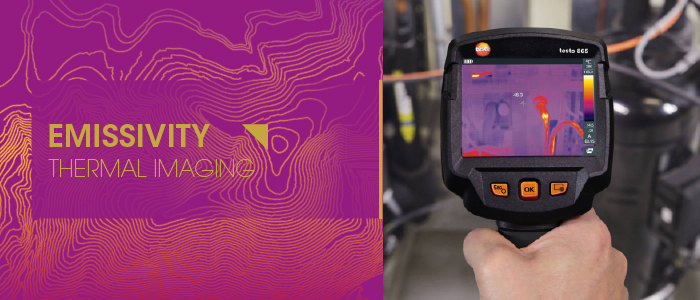
One of the first things that everyone will notice about our thermal imaging cameras and infrared thermometers is that the emissivity capabilities are defined for every single product. Emissivity is either fixed - typically at 0.95 - or adjustable at varying increments between 0.1 and 1 in most thermal imaging cameras. This article aims to explain what emissivity is, how it is determined, and the practical challenges it presents for thermographers and technicians.
What is Emissivity?
Emissivity is defined as the capability of any material or object to radiate thermal energy.
Different materials radiate heat with different efficiencies with darker, duller materials tending to be better thermal emitters whilst brighter, shinier surfaces tend to be worse thermal emitters. However, appearance is not an accurate guide to emissivity as different surfaces of the same colour, such as white paint, paper or marble, might all have different emissivities.
The different thermal properties of these materials have various practical applications when used in industry. Firstly, the heating elements of kettles are often black as this transfers heat more efficiently to the water whilst insulated windows are covered in a transparent low-emissivity coating in order to better insulate properties. Solar water heating systems meanwhile use low-emissivity surfaces in order to transfer as much of the Sun’s energy as possible to the water.
How is Emissivity Quantified?
Emissivity is expressed as a number between 0 and 1 which defines the ability of a material or object to emit thermal radiation. Objects with no emissivity whatsoever would have a value of 0 and objects that emit maximum energy at any frequency would have a value of 1. In reality, almost all materials with be somewhere in between.
As emissivity is equal to absorptivity, it is impossible for an object to have an emissivity of greater than 1 because a perfectly black body can only absorb a maximum of 100% of radiated thermal energy. A material with emissivity of 0 emits no thermal energy through radiation but it is also 100% reflective of heat, so it is known as a ‘perfect thermal mirror’.
Some common materials have the following emissivity values:
- Red brick: 0.90
- Cement: 0.54
- Oxidised copper: 0.65
- Glass: 0.92
- Paper, white: 0.68
- Silver, polished: 0.02
- Silver, oxidised: 0.04
- Soil: 0.92
- Stainless steel: 0.59
- Water: 0.95
Conveniently, most good quality thermal imaging cameras will have emissivity tables built in, so the closest possible value can be selected by choosing the material that is in front of you.
How does Emissivity Affect Thermal Imaging?
Differing emissivity poses a challenge to those working thermal imaging cameras. For example, an object made out of multiple different materials might appear to be at different temperatures whilst in fact it is at a uniform temperature, or alternatively a component that is running hot might appear to be OK if it has a low emissivity value. Similarly, someone using an IR thermometer to check that food is stored at an appropriate temperature might get wildly different values depending on which surface is being measured.
It is therefore important that the user can define the emissivity of the surface they wish to measure before conducting measurements and/or thermographic inspections. Once emissivity is correctly adjusted, thermal imagers and infrared thermometers can compensate their measurements based on the emissivity value and provide the most accurate temperature readings possible.
